Have you noticed larger than usual hornets during your recent trips outside? If so, it was perhaps a European hornet, an insect increasingly present in Quebec.
• Read also: A giant wasp from Europe and Asia invades Quebec: have you seen it?
Here are six things to know about this species twice the size of a “regular” wasp.
Number on the rise in Quebec
The first sightings of this species were made in Ontario around 2016.
They were spotted in 2019 in Quebec, a “very rapid” progression, according to Étienne Normandin, entomologist at the University of Montreal.
The number of sightings of these insects in the province would have increased by 377% between 2023 and 2024.
Their rapid proliferation is partly caused by the mild winters of recent years.
“We have winters that are much milder, shorter, springs that are warmer and that is perfect for wasps in general. […]. If we have milder winters, [le frelon] can survive longer,” says the entomologist.
Soon in Montreal
Although European hornets have only been spotted in western Quebec so far, they could appear in Montreal “within one to two years,” according to Étienne Normandin.
For the moment, the insects have been seen in the Outaouais, Témiscamingue and the Laurentians.
Impressive size
What is most surprising about the European hornet is its size.
This flying insect can measure between 18 and 40 millimeters, while the native hornet, which is usually seen in Canada, measures between 7 and 18 millimeters.
Screenshot/TVA News
Lover of big cities
The European hornet particularly appreciates urban spaces.
“It is almost exclusively distributed in urban habitats, so cities […] and climate change is making cities warm up more quickly, so they will benefit from these environments,” explains Étienne Normandin.
No more dangerous than a wasp, but…
Despite its impressive size, the European hornet is no more dangerous than an “ordinary” hornet.
Like the wasp or the bee, the hornet only stings if it feels threatened.
It can also sting several times since it does not leave its stinger in the skin.
- Listen to the column by Marianne Bessette, research journalist via OLD:
However, European hornet stings can be more dangerous for allergy sufferers due to their large size.
“A European hornet sting is a little stronger, a little more painful than a honey bee or domestic bee sting,” says Étienne Normandin.
How to get them off your plate?
If a European hornet hovers around you during a meal on a patio or a day at the park, don’t try to chase them away by hitting them.
“What you can do is take your napkin and block the wasp’s view. So she’s going to fly, she’s going to tread water. What we want to do is keep it hovering in place for as long as possible and at some point, it will run out of energy and will look elsewhere,” explains the entomologist from the University of Montreal.
– With information from Anne-Sophie Poiré






